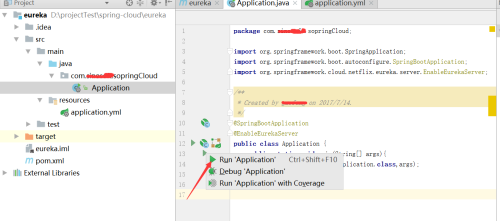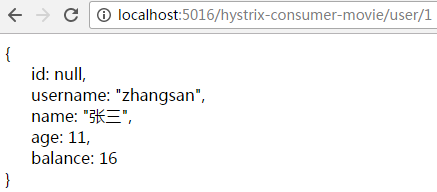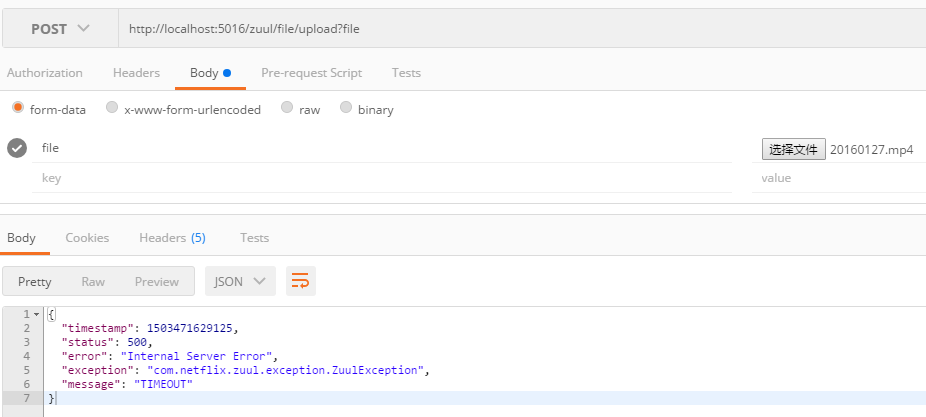springCloud(15):使用Zuul构建微服务网关-Header与文件上传和过滤器
一、Header 1.1、敏感header的设置 一般来说,可在同一个系统中的服务之间共享Header,不过应尽量防止让一些敏感的Header外泄。 1 2 3 4 zuul: routes: provide-user: sensitive-headers:Cookie,Set-Cookie 说明:敏感的header不会传播到下游去,也就是说此处的Cookie,Set-Cookie不会传播的其它的微服务中去 1.2、忽略的Header 可以使用zuul.ignored-headers属性丢弃一些Header,如: 1 2 3 4 5 zuul: routes: provide-user: sensitive-headers:Cookie,Set-Cookie ignored-headers:Authorization 说明:忽略的header不会传播到下游去,也就是说此处的Authorization不会传播的其它的微服务中去,作用与上面敏感的Header差不多,事实上sensitive-headers会被添加到ignored-headers中。 注意: 1、默认情况下zuul.ignored-headers是空的 2、如果Spring Security在项目的classpath中,那么zuul.ignored-headers的默认值就是Pragma,Cache-Control,X-Frame-Options,X-Content-Type-Options,X-XSS-Protection,Expires,所以,当Spring Security在项目的classpath中,同时又需要使用下游微服务的Spring Security的Header时,可以将zuul.ignoreSecurity-Headers设置为false 二、使用Zuul上传文件 1、对于小文件(1M以内)上传,无须任何处理,即可正常上传。 2、对于大文件(10M以上)上传,需要为上传路径添加/zuul前缀。 注意:这里的上传路径添加/zuul前缀无须配置 zuul的配置: 1 2 3 zuul: routes: file-upload:/file/** 测试上传:上传文件200多M zuul端抛出超时异常: 1 Causedby:com.netflix.hystrix.exception.HystrixRuntimeException:file-uploadtimed-outand no fallbackavailable. 解决:在zuul的yml配置文件中加入如下配置: 1 2 3 4 hystrix.command. default .execution.isolation.thread.timeoutInMilliseconds:60000 ribbon: ConnectTimeout:3000 ReadTimeout:60000 再次测试上传:上传文件200多M 三、过滤器 3.1、过滤器类型与请求生命周期 Zuul大部分功能都是通过过滤器来实现的。Zuul中定义了4种标准过滤器类型,这些过滤器类型对应于请求的典型生命周期。 PRE 这种过滤器在请求被路由之前调用。可利用这种过滤实现身份验证、在集群中选择请求的微服务、记录调试信息等。 ROUTING 这种过滤器将请求路由到微服务。这种过滤器用于构建发送给微服务的请求,并使用Apache HttpClient或Netfilx Ribbon请求微服务。 POST 这种过滤器在路由到微服务以后执行。这种过滤器可用来为响应添加标准的HTTP Header、收集统计信息和指标、将响应从微服务发送给客户端等。 ERROR 在其它阶段发送错误时执行该过滤器。 Zuul请求的生命周期如图: 3.2、自定义过滤器 Zuul还允许创建自定义的过滤器类型。继承抽象类ZuulFilter即可。 自定义过滤器需要实现以下方法: a、filterType:返回过滤器的类型。有pre、route、post、error等,分别对应着上面的过滤器,详细可以参考com.netflix.zuul.ZuulFilter.filterType()中的注释。 b、filterOrder:返回一个int值来指定过滤器执行的顺序,不同的过滤器允许返回相同的顺序。 c、shouldFilter:返回一个boolean值来判断该过滤器是否要执行,true表示执行。 d、run:过滤器的具体逻辑。 这里编写一个记录请求日志的过滤器。 1、新建一个类LogFilter继承抽象类ZuulFilter 1 2 3 4 5 6 7 8 9 10 11 12 13 14 15 16 17 18 19 20 21 22 23 24 25 26 27 28 29 30 31 32 33 34 35 36 37 38 39 40 41 42 43 44 package com.liuy.filter; import javax.servlet.http.HttpServletRequest; import org.slf4j.Logger; import org.slf4j.LoggerFactory; import com.netflix.zuul.ZuulFilter; import com.netflix.zuul.context.RequestContext; /** *打印请求日志 *记录请求日志的过滤器 *@description记录请求日志的过滤器 *@authorluis *@version1.0 *@date:2017年8月23日下午3:58:55 */ public class LogFilter extends ZuulFilter{ private static final LoggerLOG=LoggerFactory.getLogger(LogFilter. class ); @Override public Objectrun(){ RequestContextctx=RequestContext.getCurrentContext(); HttpServletRequestrequest=ctx.getRequest(); LogFilter.LOG.info(String.format( "打印日志:send%srequestto%s" ,request.getMethod(),request.getRequestURL().toString())); return null ; } @Override public boolean shouldFilter(){ return true ; } @Override public int filterOrder(){ return 1 ; } @Override public StringfilterType(){ return "pre" ; } } 2、修改启动类 1 2 3 4 5 6 7 8 9 10 11 12 13 14 15 16 17 18 19 20 21 22 23 24 25 26 27 28 29 package com.liuy; import org.springframework.boot.SpringApplication; import org.springframework.boot.autoconfigure.SpringBootApplication; import org.springframework.cloud.netflix.zuul.EnableZuulProxy; import org.springframework.context.annotation.Bean; import com.liuy.filter.LogFilter; /** *Zuul微服务网关-过滤器 *@descriptionZuul微服务网关-过滤器 *@authorluis *@version1.0 *@date:2017年8月22日下午2:54:04 */ @SpringBootApplication @EnableZuulProxy public class Application{ public static void main(String[]args){ SpringApplication.run(Application. class ,args); } /**自定义过滤器*/ @Bean public LogFilterpreRequestLogFilter(){ return new LogFilter(); } } 3、测试 a、依次启动eureka-server(4010)、provide-user(4011)、hystrix-consumer-movie(5012)、microservice-gateway-zuul-filter(5017) b、访问http://localhost:5017/hystrix-consumer-movie/user/1 效果: 3.3、禁用过滤器 Spring Cloud默认为Zuul编写了一些过滤器,如DebugFilter、FormBodyWrap-perFilter等,这些过滤器都放在spring-cloud-netflix-core这个jar包的org.springframework.cloud.netflix.zuul.filters包中。在某些场景下,我们可能需要禁用某些过滤器。 禁用方法非常简单,只需设置zuul.<SimpleClassName>.<filterType>.disable=true即可禁用SimpleClassName对应的过滤器。 以org.springframework.cloud.netflix.zuul.filters.pre.DebugFilter为例,如: 1 zuul.DebugFilter.post.disable=true 以前面我们自定义的com.liuy.filter.LogFilter为例,如: 1 zuul.LogFilter.pre.disable=true 本文转自我爱大金子博客51CTO博客,原文链接http://blog.51cto.com/1754966750/1958684如需转载请自行联系原作者 我爱大金子








